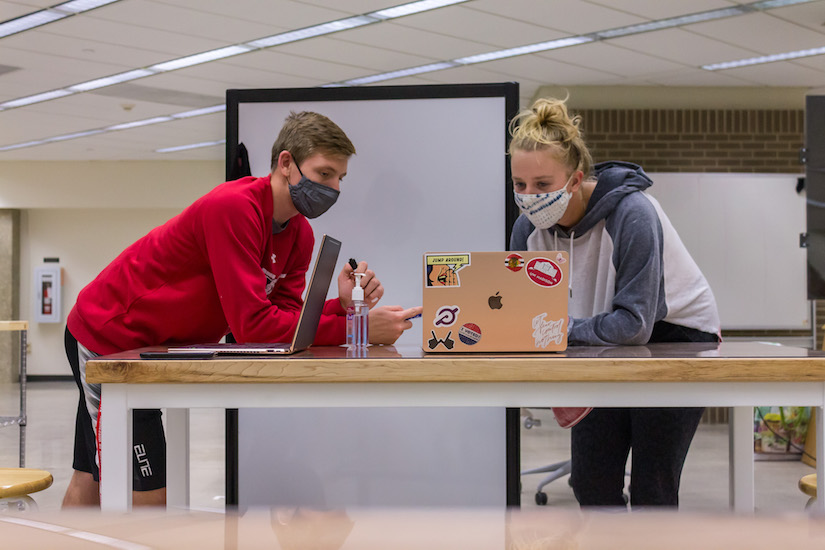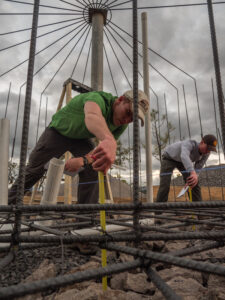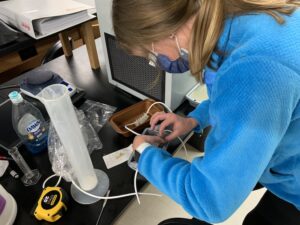Engineering students learn by solving real-world problems

Engineering students work on a magnetic shield system to protect astronauts on long interplanetary journeys. Photo courtesy College of Engineering
At the University of Wisconsin–Madison, engineering students take classes from professors whose innovative research unlocks the knowledge and technologies needed to create tomorrow’s advances.
Those students also have many opportunities to apply their engineering education to real-life challenges.
In other words, they learn engineering by doing it — and in the process, they help people and acquire a host of other valuable skills.

Engineers Without Borders UW–Madison students worked with locals in Zapote, Guatemala, to build a new water system that brings clean water down to the town from a nearby town. Submitted photo
“Students get to work in teams, and they deal with real-life situations, including conflicting design ideas, team management styles, pressure from deadlines, and fabrication issues,” says John Murphy, a faculty associate in engineering physics at UW–Madison who is among the instructors for College of Engineering freshman design classes. “The students interact with clients, and they must develop budgets, plans, meeting times, schedules, and formally go through a design process that optimizes a variety of potential solutions their team has brainstormed.”
Reflective of the various disciplines within the College of Engineering, these client-based design projects vary widely, yielding everything from medical solutions and assistive technologies to process improvements and product analyses to building concepts and beyond. Often, prototypes are among the deliverables, which also include a detailed design report with drawings and a final presentation to the client.
“Ultimately, the student teams have to understand not only the problem and accompanying physics, but also how to function as a real team interacting with a client,” says Murphy.

Biomedical engineering student Megan Baier positions a plastic spine before the group pours the gel into the model.
He also says that students overwhelmingly enjoy a class that enables them to put their calculus, chemistry, physics and other knowledge to use.
“It allows them to immediately feel what it’s like to be an engineer,” he says. “And, the freshman design class is a wonderful recruitment and retention tool for young engineers.”
Engineering students at all levels of their undergraduate education acquire project-based design experience through their courses. They also can hone design, teamwork and leadership skills in many ways outside the classroom—among them, through participation in co-curricular activities such as engineering student organizations.
The College of Engineering offers more than 50 student organizations—several of which center around competitive design challenges (think: building a futuristic mode of transportation or a concrete canoe you can actually paddle) or service projects (think: partnering with a community to assess how green streets can alleviate runoff, or working with residents of a rural African community to design and construct a safe, sustainable school building).
The following are among several examples of the ways in which students are making the world a better place, making a positive impact on people’s lives, and engineering the future—today.
- Working with Dr. Brady Hauser, a resident in the UW–Madison Department of Pediatrics, a team of biomedical engineering undergraduates created a newborn-sized training simulator that would allow aspiring doctors to practice performing spinal tap procedures on infants under the guidance of ultrasound imaging. The core of the device is a 3D-printed, newborn-sized spine surrounding a silicone tube containing water (to mimic cerebrospinal fluid), all of which is encased in a gel composed of a liquid PVC polymer mixed with mineral oil. If the project continues into the 2021-22 academic year, the team would like to use open-source CT scans and 3D printing to add more of the key anatomical landmarks that physicians look for when performing the procedure. “Within six months, we went from absolutely nothing that we know of and nothing on the market to now they’re producing several prototypes that are testable and that we’re fine tuning,” says Hauser. Read more.
- In fall 2020, a team of industrial engineering seniors studied how to improve teacher retention and recruitment in the Adams-Friendship School District in central Wisconsin, where the district lost roughly a fifth of its teaching staff in summer 2018 and again in 2019. Working with the district administrator, Tom Wermuth, the students gathered input from district administration and surveyed teaching staff, then analyzed the responses. Empowering teacher voices to enhance their sense of investment in the district was a common thread, and the students’ recommendations for addressing issues included new leadership training, school and district value-defining workshops, goal-setting activities, and streamlined internal communications. “The students went above and beyond in providing us information and just a really different way to look at the problem that’s occurring in our district and occurring in a lot of other rural districts across the state of Wisconsin,” says Wermuth. Read more.
- In fall 2020, four freshmen teams in the College of Engineering’s multidisciplinary design course developed concepts for a futuristic magnetic shielding system that could protect astronauts on long-term space journeys from harmful radiation. Past magnetic shielding systems have been hampered by challenges such as weight and power supply—but technology advances are helping to make the systems feasible. Their clients — Pablo Desiati, a senior astrophysicist with the Ice Cube Neutrino Observatory, and Elena D’Onghia, an associate professor of astronomy at UW–Madison, hope to work with NASA on developing a solution — and the students’ designs were a great start. “We might arrive at the class with our own concepts in mind, but if we give students a spark and the chance to work, they might come up with some idea that we’ve never even thought of before,” says Desiati. “And indeed, they did. Each of the teams brought a different perspective on how to work on this problem. We gave them a skeleton and they asked questions to fill it out. I even took notes from their questions.” Read more.
- Wisconsin Autonomous, a team of UW–Madison students from across several majors, is participating in the SAE International and General Motors AutoDrive Challenge II. The team is among 10 collegiate teams chosen to participate in the four-year competition, which charges them with developing and demonstrating an autonomous vehicle that can navigate urban driving courses. To perfect their vehicle, Wisconsin Autonomous members will leverage their knowledge of sensing technologies, computing platforms, software design and implementation, and advanced computation methods such as computer vision, image processing, machine learning, artificial intelligence, sensor fusion and autonomous vehicle controls. “Applying and combining what we learn in courses to hands-on projects takes understanding of those concepts to a whole new level,” says team leader Alex Pletta, a senior majoring in mechanical engineering. “Our team is special because of how we’ve brought together passionate, collaborative students who have superb technical talent and love learning.” Read more.
- Students in the UW–Madison chapter of Engineers Without Borders use their knowledge to help make a major difference in the lives of people in locations across the world. In 2020, they wrapped up projects in the rural community of Zapote, Guatemala, and in Mayaguez, Puerto Rico. In Guatemala, more than 100 UW–Madison students and townspeople worked together on a system that brought water from a mountain spring to approximately 130 homes in Zapote, nearly a three-hour hike away. In hurricane-decimated Puerto Rico, the students initiated a project to be a 25-kilowatt photovoltaic solar panel array with more than 90 panels at a children’s shelter in Mayaguez. Read more.
Enjoy this story?
Read more news from the College of EngineeringSubscribe to Wisconsin Ideas
Want more stories of the Wisconsin Idea in action? Sign-up for our monthly e-newsletter highlighting how Badgers are taking their education and research beyond the boundaries of the classroom to improve lives.
